Detailed description and photo
Leaf plates are considered the main advantage of the whole plant due to their luxurious appearance. The color of the leaves is deep green. On top of the leaf, thin silvery stains appear in the light, which are located across the leaf. For this feature, the orchid received its second name - tiger.
On the reverse side, the plates are painted in lilac, sometimes in purple (read more about what shades of color an orchid has, read here). In structure, the sheet plates are quite soft, they reach a height of half a meter, they are oval in shape.
The rhizome takes on a silvery-green hue, they are flat in structure.
Floral arrows can be green or brownish. They are round in shape. Peduncles tend not to grow up, but hang from a flowerpot. In length, their height reaches a meter.
To get a beautiful flower arch, you need to tie the peduncles to the sticks at the very beginning of growth. Up to five flowers can grow on one arrow at a time.
Breeding methods for wild cat orchids at home
The wild cat reproduces quite simply by vegetative means. There are two main ways to do this:
| Breeding method | What plants are suitable for |
| Children on peduncles | For young and strong plants that have entered the flowering age. |
| By dividing the stem | For older specimens requiring rejuvenation |
The formation of children on the peduncles of the Wild Cat does not occur often and requires increased attention from the florist:
- If the Wild Cat has released the baby, you need to strictly adjust the feeding and watering. With a lack of nutrition and moisture, the baby will hang on the mother plant for a long time, not trying to put down its own roots.
- It is considered normal if the baby has no roots for 4 months. If they do not exist longer, root formation stimulation is necessary.
- It is necessary to stimulate root formation in a child without separating from the peduncle. To do this, a moistened lump of sphagnum is fixed at the place where the baby is attached to the arrow. Moss is moistened by spraying daily until roots appear.
After the roots appear, the baby can be safely separated from the arrow and put in a separate pot.
By dividing the stem, they not only rejuvenate old plants, but also get two from one copy. For this, the trunk of the orchid is cut approximately in half. After processing the sections, the top is rinsed with a solution of succinic acid and placed on rooting. The remaining lower part is protected from decay. After a while, it will start to grow a side rosette.
Wild cat orchid owners reviews
Among orchid growers who have the Wild Cat variety in their collection, the opinion about this orchid is positive:
“I really like this variety. Not only because the flowers are so beautiful. Stamina and fertility are more striking. My Wild cat can produce 2-3 peduncles at a time and feels normal. I feed him no more than my other orchids, but the difference in the abundance of flowering is felt ”(Elvira, Moscow).
Phalaenopsis care
Wild cat orchids are considered unpretentious, but in order for them to have a healthy look and please with their large abundance of flowers of extraordinary wild beauty, it is necessary to provide them with good care.
- correct transplant procedure;
- ensuring the required temperature regime;
- correct watering and feeding;
- lighting;
- prevention against diseases and pests.
Transfer
Phalaenopsis is transplanted once every few years, as this procedure is stressful for him. It is necessary to transplant a flower in the event that the root system has become cramped or, the roots have begun to rot, and have also been damaged. The reason for the transplant may be an unstable container and a lack of substrate in the pot. For transplanting you need:
- prepare a new pot, it is better to use a transparent one with a lot of drainage holes;
- pour a drainage layer on the bottom;
- carefully remove the orchid from the old pot;
- lower into a new container, placing small pieces of foam under the root collar;
- fill empty cavities.
The substrate can be purchased at the store or prepared by mixing pre-steamed pine bark, sphagnum moss, fern roots, charcoal and expanded clay for drainage.
After the purchase, the Wild Cat Orchid is transplanted only if it is damaged. The purchased flower for 1-1.5 weeks must be placed in a place with diffused sunlight, leaving it without watering, spraying and fertilizing. If the substrate is very dry, then you need to water the plant.
Temperature regime
Phalaenopsis Wild cat adapts well to the home environment. But although he is a hybrid, it still belongs to tropical plants. Therefore, for better growth and flowering, it is necessary to provide the flower with conditions as close to natural as possible.
The air temperature in the room with the orchid should be maintained at + 22-25 degrees in the daytime and + 17-20 at night. The temperature difference between day and night values should be within 5-6 degrees. The temperature must not be allowed to drop to 15 degrees, which can harm the plant.
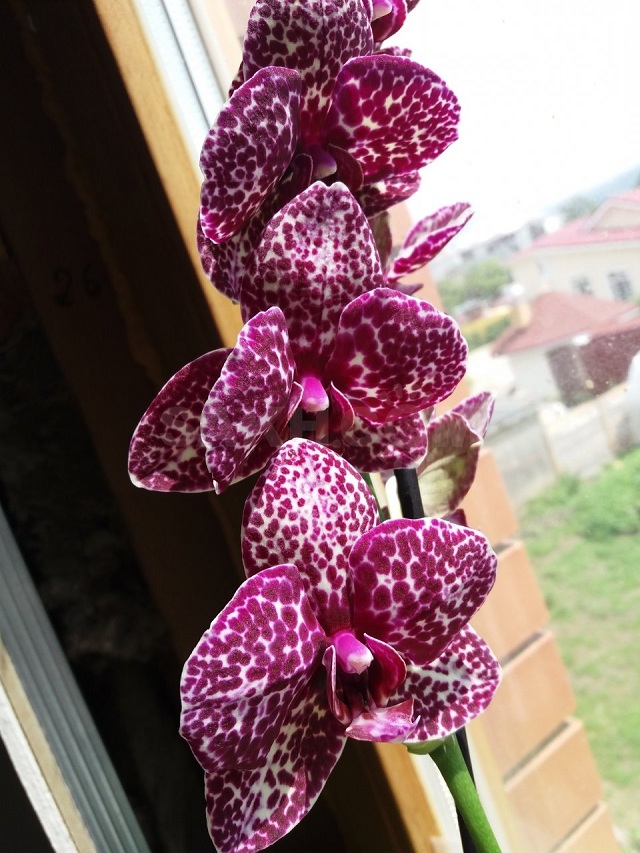
It is equally important to maintain the required air humidity of 40-70%. The orchid needs ventilation, but is afraid of drafts, which must also be taken into account when caring for it.
Phalaenopsis prefers diffused and soft light. Avoid direct sunlight, which can burn foliage and flowers. A more suitable place for placement is the windows facing the east side. During the scorching sun, the plant should be shaded. In the autumn-winter season, it is necessary to provide him with 10-12 hours of lighting, which will be helped by phytolamps or artificial light devices.
Watering
Watering the orchid should be moderate. The flower is watered as the roots and substrate dry
It is important to avoid constant waterlogging, which can lead to rotting of the root system. In hot weather, the amount of watering increases, in cooler weather it decreases.
The water used for irrigation should be soft, well-settled or boiled, at room temperature. It is important to dry the roots after moistening. And it is necessary to water the Phalaenopsis Wild cat according to the method: watering + drying.
With every third watering, complex preparations are introduced, specially designed for orchids. To do this, their concentration should be reduced 2-3 times from that indicated in the instructions.
Stimulation
Phalaenopsis Wildcat blooms twice a year, but with good care it can bloom at any time throughout the year. It happens that a plant develops well, but does not begin to bloom for a long time. In this case, you need to stimulate the orchid. To do this, provide the flower with dry coolness. During a cold snap, stop watering and spraying for 2-3 days. After 2-3 weeks, peduncles should appear in the leaf axils.
Another method of stimulation is to remove the top layer of the substrate. In its place, fresh nutritious soil is poured. 1/5 of the soil is changed. You can also stimulate flowering by applying the fertilizer "AVA", which does not contain nitrogen. The amount of top dressing is 3-4 crystals.
Botanical characteristics
Epiphytic and lithophytic varieties
Most of the species of Celogyne are epiphytes that grow on trees. There are not so many lithophytic varieties, but there are species that are both epiphytes and can grow on rocks or stones. There are very few terrestrial species.
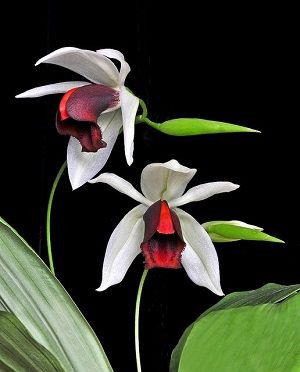 The most famous epiphytes of Tselogin:
The most famous epiphytes of Tselogin:
- wide-winged (Coelogyne brachyptera);
- comb (Coelogyne cristata);
- fringed (Coelogyne fimbriata);
- drooping (Coelogyne flaccida);
- brown (Coelogyne fuscescens);
- Lawrence (Coelogyne lawrenceana);
- speckled (Coelogyne lentiginosa);
- Massange (Coelogyne massangeana);
- Moore (Coelogyne mooreana);
- veined (Coelogyne nervosa);
- fragrant (Coelogyne odoratissima);
-
Schiller (Coelogyne schilleriana) and many others.
Epiphytes, which can also be lithophytes:
- corymbose (Coelogyne corymbosa);
- graceful (Coelogyne speciosa);
- Swan (Coelogyne swaniana);
- felt (Coelogyne tomentosa);
- three-veined (Coelogyne trinervis);
- Coelogyne usitana;
-
lovely (Coelogyne venusta) and others.
Plant structure
The Tselogin family is so numerous and varied in size and shape.
A common feature for all is sympodial growth - a type of branching with horizontally growing shoots, called pseudobulbs, which are interconnected by a rhizome (rhizome).
The structure is standard for orchids - stem, leaves, roots, peduncles.
Height of an adult plant
Depending on the species, the height can be from 15 to 30 cm.Pseudobulbs, thickened aerial or aerial roots in height also vary significantly, from 3 to 12 cm.
Number of leaves
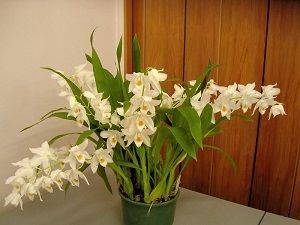 The leaf shape is either elongated-oval, or lanceolate-belt-shaped, with a sharp tip. In some species, venation is noticeable on the inside.
The leaf shape is either elongated-oval, or lanceolate-belt-shaped, with a sharp tip. In some species, venation is noticeable on the inside.
The color of the leaves is rich, from bright green to dark emerald.
The length can reach 25-30 cm, with the width of the leaf plate up to 5 cm.The number of leaves originating in each group of pseudobulbs is from 1 to 3.
Maximum peduncle length
Before the winter period, drooping peduncles usually form from the base of the pseudobulbs. The length is in direct proportion to the type of Celogin and varies from 20 to 60 cm.
Diameter, flower shape
It is the shape of the flower, which resembles either a butterfly, or a lady's shoe, or located on a bumblebee flower, that arouse such interest among flower growers. Each flower has 5 narrow, lanceolate, splayed sepals.
In the center of the flower is a three-lobed, narrow lip. Its lateral lobes are colored orange or red. And at the base you can see several protruding comb-like growths.
The diameter of flowers, depending on the species, can be up to 10 cm.

Celogin's flower.
Important! Almost all varieties of Celogin have a delicate and unpleasant aroma.
How to care?
This plant is considered a difficult flower to grow - it needs to create proper care, which includes several stages.
First of all, the plant must go through the adaptation stage. At this time, he needs good lighting and the right temperature conditions. The air temperature in the place of its growth should not exceed 25 or drop below 14 degrees
In addition, it is important for an orchid to maintain an indoor air humidity of no higher than 50 percent.
After purchase, the orchid can remain in the same pot for several years. A transplant should be done only when absolutely necessary and only after the plant has faded. After flowering, it is recommended to put phalaenopsis in a cooler place, and also significantly reduce its watering.
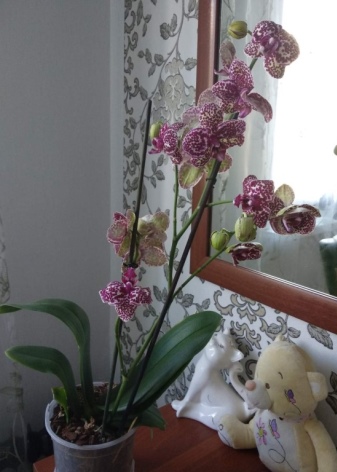
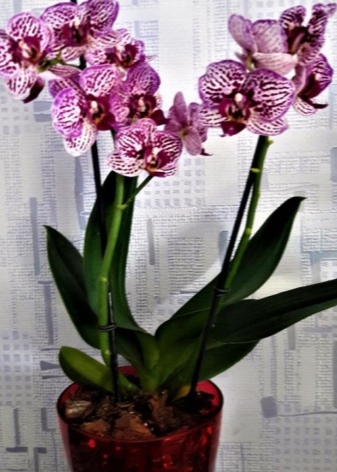
Very often, orchids stop blooming after purchase. Then you will need to stimulate the plant. To do this, try to slightly increase the difference between daytime and nighttime. In addition, a special soil is needed for the orchid, which is recommended to be bought in flower shops. Most often, this soil consists of pine bark and charcoal. And also it includes sphagnum moss; if not, you can add it yourself. In addition to all these components, fern root or special coconut chips are added to the soil.
Top dressing
You should also not forget about the introduction of different fertilizers. They are simply necessary for these plants living in ordinary bark. Most often, fertilizers are added to the water. It is recommended to do this after every third watering. Fertilizers for orchids are most commonly sold at flower shops.
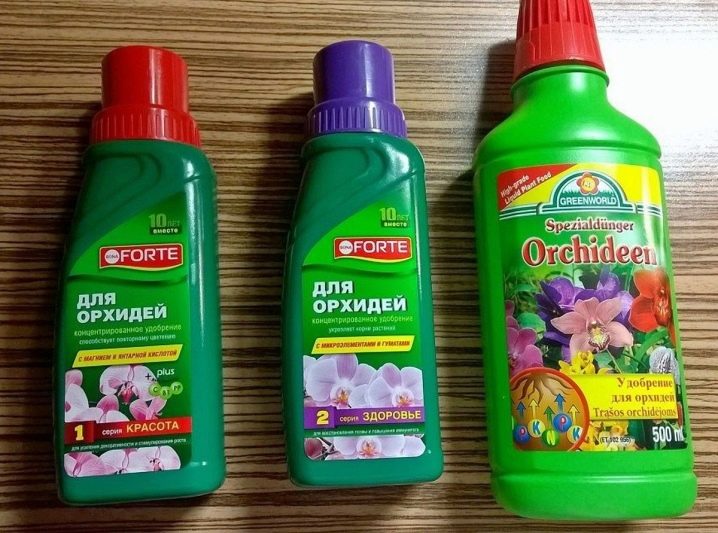
Watering
To retain moisture, sphagnum moss is often used, which needs to cover the roots of the plant. It protects the orchid from heat, and also prevents moisture from evaporating quickly.Watering the "Wild Cat" orchid also needs to be done correctly. She feels better in case of lack of water than in excess of moisture.
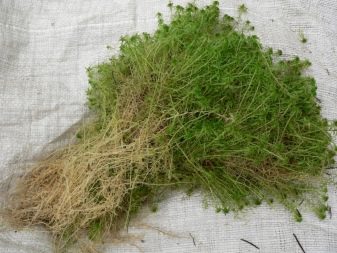
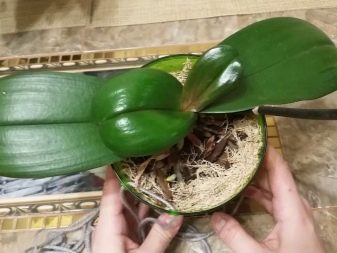
There are several ways to water such a plant. One of them is that the pot is immersed in a container of boiled and chilled water for about half an hour. Then it must be removed from the water and allowed to drain off excess moisture. Further watering can be done only when the bark is completely dry. It is imperative to monitor the state of the root system. Until the condensation on the walls of the pot disappears, the plant does not need to be watered.

Disease and pest control
The orchid differs in that with proper care it practically does not get sick. And if he gets sick, then he is treated quickly enough. These diseases include different types of rot. For example, gray rot and fusarium. To get rid of them, you need to cut off the infected area, then sprinkle the cut area with coal powder or treat it with a special disinfectant solution.
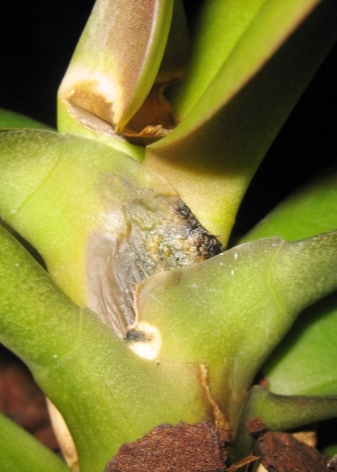

But only various pests can greatly spoil the life of an orchid, and a novice florist. In this case, the plant begins to dry out and wither. Such plants must be immediately isolated, and the window and sill must be treated with a special soap solution with the addition of baking soda. The proportions in this case are equal: 1 teaspoon of baking soda to 1 glass of soap solution. This mixture will stop the reproduction of parasites.
Among other things, the plants that were nearby should also be treated with soapy water, but only without using soda. After a while, they must be rinsed with clean water. In case of damage by a nematode, the orchid must be treated with a decaris solution or other special means. If aphids appear, then the plant must be immediately treated with an onion solution or a solution from lemon peel. Such folk remedies are infused for three days. After that, they are ready for use.
If phalaenopsis is affected by soft-bodied mites, then they must be dealt with only with special preparations. It could be Fitoverm. If shell mites appear, then the plant must be transplanted, but before that, be sure to soak it for at least half an hour in warm water so that the insects float up. After that, they must be collected, and the roots of the plant must be dried. Only then can the plant be transplanted into a new soil.

Pruning
You should not prune the orchid immediately after flowering. In addition, only those peduncles that are completely dry can be removed. It is necessary to cut the flower to the very first dormant bud. A new process may subsequently appear from it.
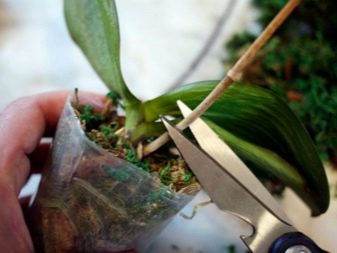
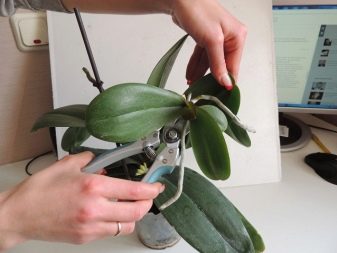
After some time, lateral pagons may appear, on which new flowers will appear.
Features of planting varieties with high decorativeness
The stems of the varieties described above can be transplanted not only after flowering, some growers recommend changing the soil during this period.
The main requirements for the substrate for such phalaenopsis:
- The mixture should contain pieces of bark of different sizes, the ratio of coarse and fine fractions is about 8: 2;
- Small inclusions of peat lumps are allowed.
You also need to be able to choose a container; a transparent plastic pot is ideal for this. It should be taken a little more than the previous one.
Clay bowls can be used to create a more sophisticated design for planting phalaenopsis. But this is provided that you can, without looking at the roots, carry out the correct watering regime.
The transplant is performed in the standard way:
- Remove the plant from the pot;
- Free the roots from the old substrate as much as possible;
- Cut off dry and rotten roots, process the cuts;
- Drainage is placed on the bottom of the prepared pot;
- Place the root system of the orchid and gently spread the pieces of bark.

Clay pots can be used to create sophisticated designs. The main thing is not to forget to water on time.
After that, the plant is left alone for 10-14 days, it is not watered, turned over, and fed.
Advice! Before planting in a new substrate, the phalaenopsis rhizome can be fed by soaking in a special nutrient solution. It can be prepared using commercially available fertilizers or natural products at home.


